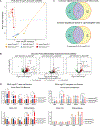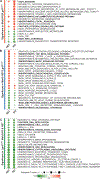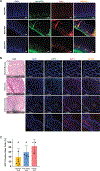The Transcriptomic Landscape of Mismatch Repair-Deficient Intestinal Stem Cells
- PMID: 34003775
- PMCID: PMC8318201
- DOI: 10.1158/0008-5472.CAN-20-2896
The Transcriptomic Landscape of Mismatch Repair-Deficient Intestinal Stem Cells
Abstract
Lynch syndrome is the most common cause of hereditary colorectal cancer and is secondary to germline alterations in one of four DNA mismatch repair (MMR) genes. Here we aimed to provide novel insights into the initiation of MMR-deficient (MMRd) colorectal carcinogenesis by characterizing the expression profile of MMRd intestinal stem cells (ISC). A tissue-specific MMRd mouse model (Villin-Cre;Msh2 LoxP/LoxP ) was crossed with a reporter mouse (Lgr5-EGFP-IRES-creERT2) to trace and isolate ISCs (Lgr5+) using flow cytometry. Three different ISC genotypes (Msh2-KO, Msh2-HET, and Msh2-WT) were isolated and processed for mRNA-seq and mass spectrometry, followed by bioinformatic analyses to identify expression signatures of complete MMRd and haplo-insufficiency. These findings were validated using qRT-PCR, IHC, and whole transcriptomic sequencing in mouse tissues, organoids, and a cohort of human samples, including normal colorectal mucosa, premalignant lesions, and early-stage colorectal cancers from patients with Lynch syndrome and patients with familial adenomatous polyposis (FAP) as controls. Msh2-KO ISCs clustered together with differentiated intestinal epithelial cells from all genotypes. Gene-set enrichment analysis indicated inhibition of replication, cell-cycle progression, and the Wnt pathway and activation of epithelial signaling and immune reaction. An expression signature derived from MMRd ISCs successfully distinguished MMRd neoplastic lesions of patients with Lynch syndrome from FAP controls. SPP1 was specifically upregulated in MMRd ISCs and colocalized with LGR5 in Lynch syndrome colorectal premalignant lesions and tumors. These results show that expression signatures of MMRd ISC recapitulate the initial steps of Lynch syndrome carcinogenesis and have the potential to unveil novel biomarkers of early cancer initiation. SIGNIFICANCE: The transcriptomic and proteomic profile of MMR-deficient intestinal stem cells displays a unique set of genes with potential roles as biomarkers of cancer initiation and early progression.
©2021 American Association for Cancer Research.
Conflict of interest statement
Conflict of Interest Disclosures:
No other disclosures are reported.
Figures





Similar articles
-
Temozolomide increases the number of mismatch repair-deficient intestinal crypts and accelerates tumorigenesis in a mouse model of Lynch syndrome.Gastroenterology. 2014 Nov;147(5):1064-72.e5. doi: 10.1053/j.gastro.2014.07.052. Epub 2014 Jul 31. Gastroenterology. 2014. PMID: 25088490
-
An Msh2 conditional knockout mouse for studying intestinal cancer and testing anticancer agents.Gastroenterology. 2010 Mar;138(3):993-1002.e1. doi: 10.1053/j.gastro.2009.11.009. Epub 2009 Nov 18. Gastroenterology. 2010. PMID: 19931261 Free PMC article.
-
Prevalence of mismatch repair-deficient crypt foci in Lynch syndrome: a pathological study.Lancet Oncol. 2012 Jun;13(6):598-606. doi: 10.1016/S1470-2045(12)70109-2. Epub 2012 May 1. Lancet Oncol. 2012. PMID: 22552011
-
Universal Immunohistochemistry for Lynch Syndrome: A Systematic Review and Meta-analysis of 58,580 Colorectal Carcinomas.Clin Gastroenterol Hepatol. 2022 Mar;20(3):e496-e507. doi: 10.1016/j.cgh.2021.04.021. Epub 2021 Apr 19. Clin Gastroenterol Hepatol. 2022. PMID: 33887476
-
Lynch syndrome and Lynch syndrome mimics: The growing complex landscape of hereditary colon cancer.World J Gastroenterol. 2015 Aug 21;21(31):9253-61. doi: 10.3748/wjg.v21.i31.9253. World J Gastroenterol. 2015. PMID: 26309352 Free PMC article. Review.
Cited by
-
Immunoprevention Strategies for Colorectal Cancer in Lynch Syndrome Carriers.Cancer J. 2024 Sep-Oct 01;30(5):352-356. doi: 10.1097/PPO.0000000000000738. Cancer J. 2024. PMID: 39312455 Free PMC article. Review.
-
Current Trends in Vaccine Development for Hereditary Colorectal Cancer Syndromes.Clin Colon Rectal Surg. 2023 Jul 31;37(3):146-156. doi: 10.1055/s-0043-1770383. eCollection 2024 May. Clin Colon Rectal Surg. 2023. PMID: 38606044 Free PMC article. Review.
-
Comparative molecular genomic analyses of a spontaneous rhesus macaque model of mismatch repair-deficient colorectal cancer.PLoS Genet. 2022 Apr 21;18(4):e1010163. doi: 10.1371/journal.pgen.1010163. eCollection 2022 Apr. PLoS Genet. 2022. PMID: 35446842 Free PMC article.
-
Insights into Early Onset Colorectal Cancer through Analysis of Normal Colon Organoids of Familial Adenomatous Polyposis Patients.Cancers (Basel). 2022 Aug 26;14(17):4138. doi: 10.3390/cancers14174138. Cancers (Basel). 2022. PMID: 36077675 Free PMC article.
-
Differential pre-malignant programs and microenvironment chart distinct paths to malignancy in human colorectal polyps.Cell. 2021 Dec 22;184(26):6262-6280.e26. doi: 10.1016/j.cell.2021.11.031. Epub 2021 Dec 14. Cell. 2021. PMID: 34910928 Free PMC article.
References
-
- Lynch HT, Snyder CL, Shaw TG, et al. Milestones of Lynch syndrome: 1895–2015. Nat Rev Cancer 2015;15:181–94. - PubMed
-
- Fearon ER. Molecular genetics of colorectal cancer. Annu Rev Pathol 2011;6:479–507. - PubMed
-
- Bonadona V, Bonaiti B, Olschwang S, et al. Cancer risks associated with germline mutations in MLH1, MSH2, and MSH6 genes in Lynch syndrome. JAMA 2011;305:2304–10. - PubMed
Publication types
MeSH terms
Substances
Grants and funding
LinkOut - more resources
Full Text Sources
Other Literature Sources
Medical
Molecular Biology Databases
Research Materials
Miscellaneous

